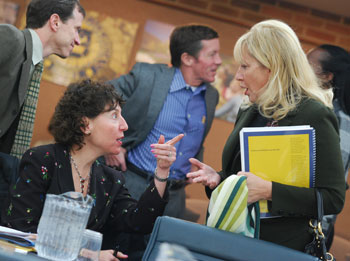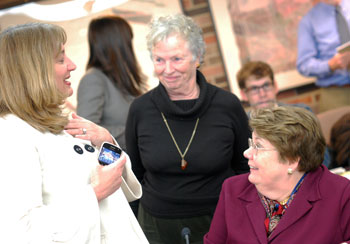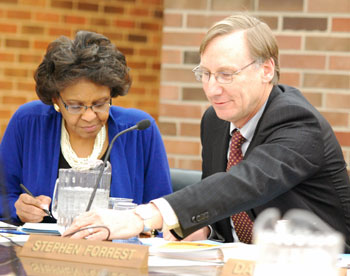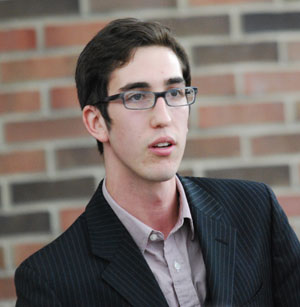UM Regents Get Updates on Research, Haiti
University of Michigan Board of Regents meeting (Jan. 21, 2010): At their first board meeting of the year, UM regents approved a raft of athletics-related projects, got an update on the university’s research efforts and applauded UM provost Terry Sullivan, who was recently named as the first female president of the University of Virginia.

UM regent Denise Ilitch, right, talks with Ora Hirsch Pescovitz, executive vice president for medical affairs, before the start of the Jan. 21 meeting of the board of regents. Ilitch, a Democrat from Bingham Farms, did not declare her candidacy for governor at Thursday’s meeting. (Photos by the writer.)
The relatively short meeting also included a report on the university’s contribution to earthquake relief efforts in Haiti.
Two people spoke during public commentary. A local Sierra Club board member, James D’Amour, told regents that the group opposed the Fuller Road Station, a joint UM/city of Ann Arbor project being built on city-owned parkland. He urged them to “take no part in this unethical act.” They later approved the project.
And UM student Alex O’Dell described his vision for TEDxUofM, an April 9 event on campus being modeled after the influential TED Talks, where speakers get 18 minutes to share “ideas worth spreading.”
President’s Opening Remarks
President Mary Sue Coleman began by referring to earthquake relief efforts in Haiti, saying that they were not aware of any UM faculty, staff or student who’d been there during the quake, ”and for that, we are very grateful.” She described the university’s efforts to raise money, collect supplies, and donate blood, among other things, and said student groups were meeting that night to coordinate their efforts too. This is not a short-term effort, she said – Haiti will require assistance in the months and years to come.

UM provost Teresa Sullivan, right, talks with regents Andrea Fischer Newman, left, and Olivia Maynard, center, after the Jan. 21 board of regents meeting. Sullivan has been named president of the University of Virginia, and will be stepping down from her UM post later this year.
Coleman also noted that earlier this month, UM provost Terry Sullivan had been named the first female president of the University of Virginia. She’ll start that job on Aug. 1.
Sullivan walked into the room as Coleman was making these remarks, prompting the regents and other executives to applaud as she made her way to her seat at the board table. She apologized for being late, reporting that she’d been on the phone with a Congressman from Charlottesville. Coleman said they’d miss Sullivan tremendously but wished her well. She joked that they’d all come to visit, since the president’s house there has lots of extra bedrooms. A formal send-off is being planned for later in the year.
Segueing to other transitions, Coleman said that 300 university employees were preparing to move into the North Campus Research Center, known as NCRC – the former Pfizer campus that UM bought in a deal that closed in June 2009. She said they’ll be the first of thousands of faculty, students and staff who’ll use the research and office facilities in the coming years, and that it’s exciting to see activity there begin to unfold. Also invigorating, she said, was a recent Detroit Economic Club event over which she presided at Cobo Center on Jan. 19. At the DEC event, Detroit mayor Dave Bing and leaders of Oakland, Wayne and McComb counties described a positive outlook for the regional economy. UM is playing a role in that, Coleman said.
Finally, Coleman noted the recent death of UM president emeritus Robben Fleming, saying that as president from 1968-78, he had signed the diplomas of many of the regents. She said he’ll be missed, and that she’s grateful for the devotion that he and his wife Sally gave to the university and to higher education.
Research Report: “A Pretty Good Year”
Stephen Forrest, vice president for research, gave a presentation at Thursday’s meeting about the university’s research efforts. Unlike reports that people are getting in the corporate world, he said, “we’ve had a pretty good year in the world of research.”

At left: Stephen Forrest, UM’s vice president for research, following his presentation to the board of regents. Next to him is Royster Harper, vice president for student affairs.
In FY 2009, which ended June 30, the university for the first time surpassed $1 billion in research spending, Forrest said – a 9.4% increase from 2008. The funding was earned competitively, he added: “There are no earmarks in that $1 billion.”
All of this happened in a year that saw the university’s largest research partner – General Motors – declare bankruptcy, Forrest said, and at a time when funding available for research is shrinking.
Last year, researchers were awarded more than $218 million in federal stimulus grants – those dollars aren’t included in the $1 billion total, he said, and will show up in the fiscal 2010 report.
Also during the year, university researchers disclosed 350 inventions – an all-time high – and launched eight start-up businesses. This was despite a market that made it difficult to get financed and in which deals “were almost impossible to put together,” he said. Venture capital investments in UM start-ups topped $82 million last year.
Research is now the third largest entity in UM’s portfolio, Forrest said, following the health system at $2.2 billion and education at $1.2 billion.
One element that will spur even more research growth, Forrest said, is the North Campus Research Center, or NCRC. He called it a “transformational opportunity,” though it’s a transformation that will happen over several years. He said the former Pfizer campus provides the collaborative space to reinvent how research is done, allowing researchers to work with businesses and government agencies, tackling “human-scale” projects – large, interdisciplinary problems in human health and sustainability/energy. Forrest said the NCRC will include operations of the UM Business Engagement Center, Technology Transfer, and possibly a faculty start-up accelerator.
To do all this, the university is cultivating a culture of entrepreneurship, Forrest said. As an example, he pointed to a presentation at last month’s regents meeting by “the Toms” – Tom Kinnear, executive director of the 10-year-old Zell-Lurie Institute for Entrepreneurial Studies at the Ross School of Business, and Thomas Zurbuchen, associate dean for entrepreneurial programs at the College of Engineering.
Forrest said he’d be asking regents to approve some policy changes in the future that would improve faculty incentives for entrepreneurial activity. He closed by showing an aerial shot of the NCRC, titled “UM’s Field of Dreams.”
Later in the meeting, Forrest also announced that Vic Strecher, a professor in the UM School of Public Health, has been named Distinguished University Innovator for 2010. Strecher founded HealthMedia Inc., an Ann Arbor firm that was acquired by Johnson & Johnson in 2008. [See Chronicle coverage: "Live at PJ's: It's HealthMedia!"] Strecher will be honored at a March 25 ceremony that will be open to the public. The event begins at 4 p.m. in the Biomedical Sciences Research Building Auditorium.
Haiti Relief Efforts
Ora Hirsch Pescovitz, executive vice president for medical affairs, gave a report on relief efforts for Haiti by members of the UM health system. The efforts are being led by Tony Denton, chief operating officer of UM Hospitals & Health Centers. Pescovitz said there’s been an extraordinary outpouring of support from the entire campus. They’ve received calls with requests to work with various federal agencies, she said, and are doing so. “We stand ready to serve in any way we possibly can,” she said.
On Jan. 20 they shipped a 40-foot container of basic medical supplies via World Medical Relief, a Detroit-based charity – the shipment should arrive in Haiti sometime next week, she said. The UMHS Survival Flight has been registered with FEMA (the Federal Emergency Management Agency) – two patients from Haiti had already been transported to UM, arriving the evening of Jan. 20. She asked that the media respect their privacy.
Pescovitz said the best way for people to help was to contribute to the American Red Cross. She also urged the media not to overstate UM’s role in relief operations, which she described as relatively small in the context of national efforts.
Regent Olivia Maynard asked how many UM medical personnel had signed up to volunteer in Haiti. Pescovitz said about 100 people had registered online, but there were very specific criteria for the medical and nursing personnel. At this point, there is one UM resident working in Haiti, she said. The university will only pay for employees who go there under the auspices of a federal agency. And people will likely stay only for two-week periods, she said, because of war-zone-type conditions.
Crisler Arena Renovations, Other Projects Approved
Regents moved through the bulk of their agenda with little discussion. All requests – including several related to UM athletics – were approved unanimously.
Renaming the Michigan Wrestling Center
Ralph and Dorothy Bahna gave $2 million to support the new Michigan Wrestling Center, and regents approved naming the facility in their honor as the Bahna Wrestling Center. The building, which opened earlier this month, is located on the university’s athletic campus on South State Street.

Bil Martin, UM’s athletic director, attended the Jan. 21 regents meeting and spoke briefly about a couple of projects that were on the agenda, including the renovations at Crisler Arena and the naming of the wrestling center.
Bill Martin, UM athletic director, was on hand at the meeting and described Ralph Bahna to the regents as a former 115 pound freshman wrestler who went on to incredible success. At UM, Bahna won an individual Big Ten championship in 1964. The $2 million gift is the largest given to UM athletics by a former varsity letter winner. Bahna is chairman of Priceline.com and was previously CEO of Cunard Lines Ltd., which he transformed from a shipping company into a cruise-line operator.
Crisler Arena
When Mary Sue Coleman asked for someone to move the agenda item for Crisler Arena renovations, regent Kathy White said, “Oh, so moved!”
The project has been on the agenda in different ways for months. At their September 2009 meeting, Don Dethlefs, CEO of the Denver-based architecture firm Sink Combs Dethlefs, showed regents the schematic designs for a $23 million addition to Crisler, a two-story, 57,000-square-foot basketball training facility that will include offices for men’s and women’s coaching staffs, locker rooms, two practice courts, film-viewing and hydrotherapy rooms, conditioning space and other amenities.
At Thursday’s meeting, regents approved the $20 renovation project for Crisler, and the selection of TMP Architecture for its design. The project includes replacing the roof and conducting asbestos abatement; installing new fire detection, alarm, and suppression systems, an emergency generator, and new heating and ventilation units; and upgrading the electrical system. The project will also replace the seats in the lower level, making changes to meet the requirements of the Americans with Disabilities Act. Those changes include relocating and widening the aisles, and adding hand rails and an elevator.
Regent Julia Darlow asked about the ADA compliance, and Hank Baier – UM’s associate vice president of facilities and operations – said they were confident that they’d meet ADA requirements. They’d been meeting with individuals and groups representing the disabled, he said, and would share the new designs with them, as well as discuss the issue with code consultants and the architects.
In a related item, regents authorized the university to issue bids and award construction contracts for the basketball training facility to be added to Crisler.
Brandon Officially Appointed
David Brandon did not join Bill Martin at the regents meeting, where Brandon’s appointment to replace the retiring athletic director was approved with little fanfare. During her opening remarks, Mary Sue Coleman described Brandon – CEO of Domino’s Pizza, a former regent and UM football player who was coached by Bo Schembechler – as “a perfect leader for our athletic program.”
Brandon’s appointment as the Donald R. Shepherd Director of Intercollegiate Athletics, effective March 8, 2010 through March 7, 2015, was approved as part of a list of other personnel actions. It was wedged between an item correcting the criteria for a professorship at the UM Medical School and the naming of Randall Repic as chair of UM-Flint’s Department of Earth and Resource Science.
A cover letter to Brandon’s appointment notes that he will remain chairman of Domino’s, a role that does not require day-to-day responsibilities.
Earlier in the meeting, during the report on fundraising by vice president of development Jerry May, regent Martin Taylor said it was notable that David and Jan Brandon had given $800,000 to the university in December. From the development report:
98,523 shares of Dominos Pizza, Inc., common stock; for the David A. and Jan Brandon Scholarship Fund and other support in the Department of Athletics, for the Brandon Professional Resource Center and Archive in the School of Education, for the David and Jan Brandon Prostate Cancer Survivor Fund in the Medical School, and for the Building Project Fund in the Museum of Art; and for support in the Stephen M. Ross School of Business and the C. S. Mott Children’s Hospital. (Valued at $798,529)
May noted that it was a payment on an earlier pledge they’d made during the university’s Michigan Difference fundraising campaign. [The Brandons pledged $4 million in 2006, half of which was earmarked for the new C.S Mott Children's and Women's Hospital. The Brandons, along with former UM football coach Lloyd Carr and his wife Laurie, lead fundraising efforts for the $523 million hospital.]
Fuller Road Station
During public commentary at the beginning of the meeting, James D’Amour – a member of the executive committee for the Huron Valley Group of the Sierra Club – spoke regarding the Fuller Road Station project, which was on the regents’ agenda.

James D’Amour spoke to the UM regents during public commentary, on behalf of the Huron Valley Group of the Sierra Club. The group opposes the Fuller Road Station being built on city-owned property that’s designated as parkland.
Identifying himself as “a proud alumni of this fine university,” D’Amour reported that at the local Sierra Club’s Dec. 14, 2009 meeting, they passed a resolution opposing the project, a joint venture between the city of Ann Arbor and the university. He said they were deeply disappointed that city officials who had recently assured citizens that parkland wouldn’t be sold without a vote by the public were now willing to convert city parkland into a parking structure.
“This violates the spirit of the city’s charter,” he told regents. “It is a breach of trust by the city with its citizens, who believed that they voted on a charter amendment that would protect and maintain its parks for generations to enjoy. The precedent of the city converting parkland to non-park uses is a disaster. The Sierra Club urges you to take no part in this unethical act.”
Regents were asked to approve the project and authorize appointing an architect. From the cover memo:
The first phase of the development of this major intermodal transportation complex is the Fuller Road Station project which includes site preparation and construction of an intermodal facility that includes: four covered bus loading/unloading zones and waiting areas; a covered area for bike hoops and lockers; parking for 1,000 vehicles (78 percent for university and 22 percent for city use); improvements to Fuller Road immediately adjacent to the site for vehicle access; and upgrades to the multi-use path along Fuller Road.
The university will manage the construction of the Fuller Road Station project. That includes building the facility on city property, following city code review and inspection, and collaborating with the city for their approval of design. This project is unique since we would be constructing the facility on city-owned property and following city building codes. We will also need approval for the lease on city-owned land since it would be for a period of greater than ten years. We will seek approval of the lease at a later date, but prior to seeking bids or awarding construction contracts for the project. A parking structure operation and maintenance agreement will be developed concurrently with design of the project. The City of Ann Arbor will manage the site preparation at an estimated cost of $3,000,000. In addition, at the City’s expense, they will undertake an environmental assessment of the property. Although there will be a temporary loss of some leased parking spaces during construction, there will be an increase of approximately 780 university parking spaces as a result of this project.
The estimated cost of the project is $46,550,000. Costs will be shared between the University of Michigan and the City of Ann Arbor in proportion to the number of parking spaces available to each (78 percent and 22 percent respectively). Total university funding, not to exceed $36,309,000 (78 percent), will be provided from Parking resources. The construction cash flow may be provided, all or in part, by increasing the commercial paper issuance under the commercial paper program, secured by a pledge of General Revenues, and authorized by the Board of Regents. The parking structure consulting fm of Walker Parking Consultants will design the project. Design is scheduled to begin immediately, and we will return with a construction schedule when we seek approval of schematic design.
D’Amour and others have spoken at recent Ann Arbor city council meetings on the same issue of parkland sale in connection with Fuller Road Station.
[See Chronicle coverage of the city council's Jan. 4, 2010 meeting and the city council's Jan. 19, 2010 meeting. The issue of using property for this project that's designated as parkland was also discussed at the Jan. 19 meeting of the city's park advisory commission. At that meeting, PAC commissioner Gwen Nystuen said the project “raises all kinds of questions and precedents that we should fully discuss.”]
Regent Julia Darlow expressed concern about the issue raised by D’Amour, and asked if it were true that the structure was being built on parkland. From the map, she said, it looked like it was now a parking lot. The property is located off of Fuller Road, just north of the UM medical complex.
CFO Tim Slottow said the university had been leasing it from the city for use as a surface parking lot for more than two decades. But he said it was a point they should clarify, since they’d be building on property they didn’t own.
Capital Outlay Request
Tim Slottow, chief financial officer, reported on UM’s capital outlay submission to the state, with requests for funding from the legislature. This year, UM is making only one request for a capital project on the Ann Arbor campus for FY 2011: renovation of the G. G. Brown Laboratory Building for the Department of Mechanical Engineering, estimated to cost $64 million.
At their June 2009 meeting, regents approved a $56 million, 66,000-square-foot addition to the building – funding for that project had previously been requested as a capital outlay submission, but the university decided to move ahead on the addition without state aid.
The main building, Slottow said, is in sore need of renovation, but “we’re not holding our breaths” that the state will approve funding. Regent Olivia Maynard asked if there was really any chance of getting state funding. Slottow deferred to Cynthia Wilbanks, vice president for government relations and UM’s main liaison with Lansing. After a long pause, Wilbanks said, “I’m always an optimist” – a remark that drew laughter from the regents.
Public Commentary
UM student Alex O’Dell gave an energetic report on plans to hold the first TEDx event at UM, called TEDxUofM 2010.

Alex O’Dell, a UM student, spoke to the board of regents about the upcoming TEDxUofM, an event he’s organizing on campus that’s modeled after the popular annual TED conference in California.
TED stands for technology, entertainment and design, and the 18-minute lectures at its conferences – known as TED Talks – are focused on what organizers call “ideas worth spreading.” TEDx events are independently organized, with guidance from the original TED.
O’Dell is organizing UM’s first TEDx event, to be held April 9, 2010 at the University of Michigan Museum of Art. The first TEDx was held at the University of Southern California and since then others have been held, within rules set by TED. But “we’re looking to put on the big one,” O’Dell said.
The theme is “Do You Realize?” and O’Dell ticked off several examples from the university: Do you realize you can make music on your iPhone? Do you realize that there’s flexible concrete?
Organizers are looking to recruit speakers, he said, as well as funding and other guidance from the regents. Speakers should be affiliated with the university or the Ann Arbor community – building connections is one of their goals, he said.
In addition to the group’s website, they can be followed on Twitter or reached at tedxuofm@gmail.com.
Coleman thanked O’Dell for coming: “I know it’s going to be a great event!”
Present: Mary Sue Coleman (ex officio), Julia Darlow, Larry Deitch, Denise Ilitch, Olivia Maynard, Andrea Fischer Newman, Andy Richner, Martin Taylor, Kathy White
Next board meeting: Thursday, Feb. 18 at 3 p.m. in the Fleming Administration Building, 503 Thompson St., Ann Arbor. [confirm date]




